« China Part III - The Yangtze River | Main | China Part V - Xian »
June 20, 2007
China Part IV - Chongqing & Dazu
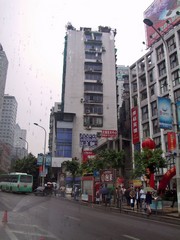 We disembarked our ship, the MV President #1 on Tuesday morning, May 15, in Chongqing. This was the only time that the tour company guide wasn’t on hand to meet us. We had to wait about 45 minutes for them to arrive after Judy got in touch to find out where they were. Best thing that could have happened – they bent over backwards for the next two days to make sure we saw and did everything. We were given all kinds of extras during the tours and at meals. We also had a super guide – Coco – who helped to make these two days great.
We disembarked our ship, the MV President #1 on Tuesday morning, May 15, in Chongqing. This was the only time that the tour company guide wasn’t on hand to meet us. We had to wait about 45 minutes for them to arrive after Judy got in touch to find out where they were. Best thing that could have happened – they bent over backwards for the next two days to make sure we saw and did everything. We were given all kinds of extras during the tours and at meals. We also had a super guide – Coco – who helped to make these two days great.
Chongqing is called “the mountain city” as it is built on hills and surrounded by mountains or “the river city” as 5 rivers cross it. It was raining most of the morning as we travelled throughout the area.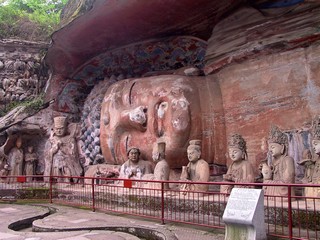

After an early lunch we drove about 130 km to the Baoding Grotto to view the rock carvings. Dazu Rock Carvings is the general name for over one-hundred cliff grottoes scattered throughout Dazu county. The construction of the grottoes began in the early 600s. They depict a wide range of subjects, stories and scenes from daily life. In total there are 60,000 statue carvings and 100,000 inscriptions in 75 locations. Our itinerary called for us to visit a second grotto however, after the 2 hour ride to get to Dazu and another 2 hours back, the group opted to visit a farm family compound instead. One of the advantages of having a smaller group – we could make those kinds of changes.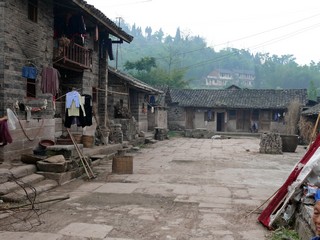
This farm compound is home to an extended family. It was built in a square with a central courtyard that led to each of the houses and also the buildings for animals and storage.

We were invited in to one of the houses and were impressed with the cleanliness even though the floors were dirt. In the bedroom, the bed was covered by a satin bedspread and the clothes hung carefully from the rafters.
In the kitchen, there was one electrical plug with extension cords to a light and a wok.
Grandmother seemed to be the one taking care of the little one. She was dressed in what we would consider more traditional clothing. The baby’s mother and other family members that we met were dressed in blue jeans, sneakers and T shirts.
There are many minority groups in China and the Tibetan heritage is evident in much of the population.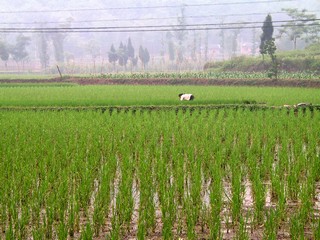
We passed acres and acres of rice paddies. Many were quite small with earthen dikes between the fields. In order to take advantage of every bit of land, the tops of the dikes, perhaps one foot wide, were often planted with corn.
This is back breaking work, as each seedling is planted by hand, bent over in a flooded field.
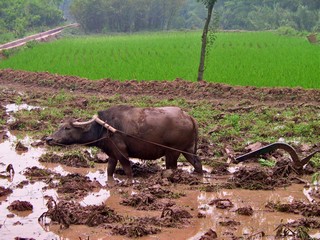
Although the rice fields in many places are first cultivated by machines, when they have been flooded, the water buffalo is still the only one that doesn’t get stuck.

From the simplicity of the farm to the cosmopolitan of the city.
Looking down from our hotel.
From our observation each city has a colour for it’s taxis. We only saw yellow in Chongqing.
Early the next morning, we took the monorail to the Chongqing Zoo. We thought it strange as we went to board, we descended two very long escalators as if we were going into a subway. However, very shortly after boarding, the train came into the open. Turns out that with the mountains in the city the monorail sometimes has to tunnel through them.
to board, we descended two very long escalators as if we were going into a subway. However, very shortly after boarding, the train came into the open. Turns out that with the mountains in the city the monorail sometimes has to tunnel through them.
This was one of the adults and she will sit and eat bamboo half the day. Because bamboo has so few vitamins, a panda must consume up to 20 kg (44 lbs) a day. They eat all parts of the plant including the stems. In the zoo, they are given other types of food such as sugar cane, carrots, sweet potatoes and special high-fibre “panda bread”.
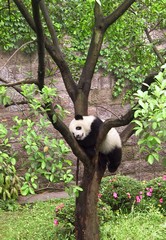
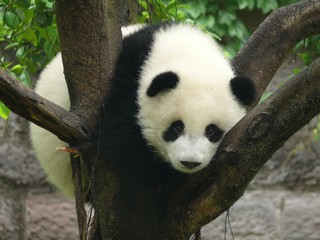
This is a year old baby that was born at this zoo. It was trying to get comfortable in the tree to have a sleep. Panda’s are not very active in captivity, interesting and endangered but not very active. I guess when you don’t have to forage for food 10 to 16 hours a day, you just get to sit around & eat instead.
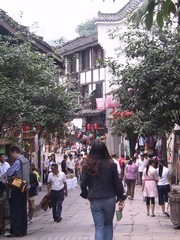
When we left the zoo we visited the Chiqikou old town area which has a history of more than 1,800 years. It is about an hours drive from the city centre and has been preserved in the midst of sprawling modern Chongqing. The name means porcelain harbour and the community prospered from the fancy blue and white porcelain of the Qing Dynasty.
The town was very busy with many vendors on the two main streets.
We had a 3 pm flight to our next stop, Xian, and after lunch we headed to the airport.
Xian is our jumping off point to see the Terracotta Warriors so our next journal is from there.
Bernie & Ross
Posted by Bernice at June 20, 2007 02:31 PM